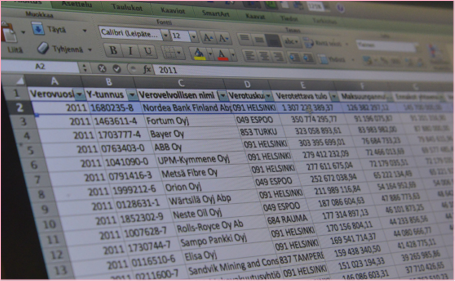Text Petja Partanen
1 Open governance – better city
If you want to incite others to open up public data, set an example, says Pekka Sauri.
If you are interested in what is going on in the capital city, follow Deputy Mayor Pekka Sauri on Twitter. Just ask his followers – thousands of people who receive
real-time updates on a variety of issues including disruptions of the public transport, movements of swans in the marina, street cleaning or power failures.

”Yes, I am active in social media, and it is in the interest of the city. I reply to people’s questions and forward whatever information I get, to others”, says Sauri.
Pekka Sauri believes that one’s own example is the best way to inspire public officials to open city data for all to use.
The departments in Sauri’s administrative sector are currently practising how to be more active in sharing information. For instance, Stara, the city’s infrastructure service company, communicates the location data of its snowploughing equipment through an interface to the production control system. The Public Works Department, on its part, receives citizen feedback through an electronic interface to the “Pitäiskö fiksata” (“Time to fix this?”) service on the newspaper Metro’s website.
”The citizens’ eyes are also the city’s eyes. The Public Works Department may not be aware that a road sign has fallen over if no one tells us about it.”
Sauri is concerned that the city organisation and the residents are too far removed from one another in a big city. Sharing information in open manner is a way to bring the citizens and governance back together to work on improving the city.
”All the data that this organisation produces should be available to everyone. Anyone can come up with ideas for what to do with it and utilise the information to the best of their abilities.”
The development has been obstructed by the vast number of different information systems and data formats used by the city – not the urge to hold back information”, states Pekka Sauri.
”Everyone knows that the Freedom of Information Act stipulates that information should be open. There are no good grounds for keeping public data resources closed.”
There is, however, one data reserve that the Deputy Mayor currently keeps hidden in his pocket. This is a 32-gigabyte dataset related to an international bridge design competition in which Sauri chairs the jury. The city has received a good amount of feedback from the citizens about the proposed bridge connection between the city centre and the eastern suburbs.
“I only have so much personal wisdom to evaluate a bridge design”, says Sauri.’
This is why he begins his work in the jury by reading the 500 citizen comments on the proposals.
”I try to incorporate the views of the experts in the jury to the opinions of the citizens.”
“All the data that Helsinki produces
should be available to everyone.”
 In spring 2012, Petri Kola contributed to the project of making Ahjo, the City of Helsinki’s electronic case management system, open to all people. An open interface to the city’s decisionmaking data was launched in March 2013.
In spring 2012, Petri Kola contributed to the project of making Ahjo, the City of Helsinki’s electronic case management system, open to all people. An open interface to the city’s decisionmaking data was launched in March 2013.
The first time in an open data workshop may be a culture shock to an experienced city official.
”It may seem slightly chaotic”, admits Petri Kola, Chairman of Open Knowledge Foundation Finland.
The people taking part in the workshops are a mixed bunch of programmers, civic activists and other curious souls. One of such meetings, held in early 2012, led to the project to unlock the data of the case management system of the City of Helsinki, Ahjo. However chaotic it may have seemed, the workshop – organised by Petri Kola – was determined to get the ball rolling. Results are achieved by working together. Anyone could join in editing the documents of the workshop – the requirement specifications and the roadmap of the project – with web tools. Online participants were able to follow the meeting via video connection. The project snowballed, leading to the launch of an open interface to Ahjo a year later. An online service titled Open Helsinki, allowing users to monitor the city’s decision-making and related discussion in real time, is currently under construction. Open Helsinki uses the open interface and is built by enthusiastic volunteers.
”This is quite different from the conventional working methods of public administration,” notes Petri Kola.
Kola’s own interest in open knowledge was originally awakened during the research project SOMUS, launched in 2009, which examined the collaboration of citizens, governance and enterprises. Sharing data proved to be an efficient way of interacting.
“Sharing data is collaboration, and from the point of view of the administration, it doesn’t tie up a lot of resources. You provide the data as selfservice and then you just see what happens.”
According to Kola, another impetus for opening governance was given – unwittingly – by former Prime Minister Matti Vanhanen who was strictly opposed to discussing political issues with the public while they were still under preparation.
“It was infuriating to see that decision-makers would simply ignore the huge amount of expertise that existed in the society outside the political system.”
There is always a lot of wisdom outside your own organisation that you can tap into by sharing knowledge, Kola points out.
The fact that the Apps4Finland contests have attracted hundreds of participants is proof that the reserves of open data can inspire a great amount of talent. But if you are a public official planning to open your information, how should you approach those with the abilities to apply the data?
“Don’t invite them to a meeting but share some of the information you have; for instance, open a dataset for them to comment”, suggests Kola.
”An easy way of getting to know the open data community is to join theFinnish Open Data Ecosystem group on Facebook.”
”There you get an insider’s view to how the community functions.”
The collective work method is a model worth considering in public administration as well. Kola believes that the working methods of many organisations are still optimised to the paper era. In the digital world, sharing knowledge and working collectively on digital products, lines of code, blueprints and visualisations may be more efficient than sitting in meetings.
”But doing things with new methods incurs a risk. And risk-taking is not necessarily awarded in public administration”, says Kola.
- •
The texts of the publication are licensed under the 'HRI-nimeä' attribution. All reuse of the material must be accompanied by the name of the author (Petja Partanen or Terhi Upola) and the publisher (Helsinki Region Infoshare).
“ There is a lot of wisdom outside your
own organisation that you can tap
into by sharing knowledge.”
2 Revise your working methods
If you also want some benefits to yourself when you open your data, you had better to rethink your working methods, says open data activist Petri Kola.
3 Efficient tax routines
The first open data release of the Tax Administration, the 2011 corporate tax data, has received a great number of downloads. In the future, the opening of data will increase efficiency in the Tax Administration, believes Senior Adviser Johanna Kotipelto.
Christmas was drawing near but Senior Adviser Johanna Kotipelto was unable to concentrate on making holiday preparations. ”Instead I was thinking to whom we should direct queries about the community tax data which we had just added to the HRI data catalogue”, she laughs.
The Tax Administration has not been in the forefront of the open data movement – for completely understandable reasons.
”Despite the general rules on the publicity of documents, tax data is classified information. It is specified in the law what part of tax information is public.”
A public debate on the attitudes of private companies towards paying taxes gave a new impetus to the Tax Administration to open its data reserves. Following the wish of Minister of Finance Jutta Urpilainen, the information on 2011 corporate taxes was released at rapid pace on the Tax Administration’s website as soon as the taxation was completed in November 2012.
“The download statistics show that the information has proved to be interesting”, says Kotipelto.
The corporate tax data has been downloaded thousands of times. In the process, Johanna Kotipelto has become rather active in the open data circles. In the autumn, she participated in the pilot class of unlocking data arranged by HRI, first of its kind in Finland.
”There I saw how data is opened in practice – all the way from SQL database extraction to a downloadable CSV file.”
She also started writing a blog about her experiences with unlocking the tax data. Now she is on the lookout for new material that would be useful if it were opened for all.
”This is an important task because it increases transparency, but at the same time it reduces our administrative burden.”
A major part of the Tax Administration’s information is classified, but, even so, each citizen is entitled to access all data concerning him- or herself.
Kotipelto has been involved in building the electronic customer services of the Tax Administration: the salary calculator Palkka.fi and the virtual tax deduction card service “Verokortti verkossa”. Still, a lot remains to be done in the field of electronic services.
”A lot of information exists, but to access it, the citizens are required to make phone calls, fill in forms or visit the tax office.”
Johanna Kotipelto hopes that the enthusiasm to open data reserves would gain more ground in all sectors of the state administration. When you put together various sources of data you can hit upon something interesting. The Trade Register is an example of a source with a lot of data that is interesting to journalists, but, for the time being, it is not cost-free.
“The financial statements delivered to the Trade Register tell a lot more about the companies’ financial accountability than an overview of the taxation”, says Kotipelto.
Johanna Kotipelto’s blog about her experiences in unlocking data:http://avaadataa.blogspot.fi/
“The download statistics show that the information has proved to be interesting”

The 300,000 rows of the first data release of the tax administration show how much tax Finnish enterprises and societies have paid during 2011.

IBM produces tools for analysing information. When the waste transport statistics of the City of Helsinki Public Works Department is analysed together with demographic data, the results will reveal which factors affect the amount of waste.
4 New businesses
Enterprises believe that opening up access to more data could create new business and even give birth to a significant new business sector in Finland.
•
The texts of the publication are licensed under the 'HRI-nimeä' attribution. All reuse of the material must be accompanied by the name of the author (Petja Partanen or Terhi Upola) and the publisher (Helsinki Region Infoshare).
A quick poll made to the IT directors of large companies
revealed that companies expect the unlocking of
data to create new business. If the Finns act quickly
in opening data, the businesses in the field may gain
a competitive advantage in the global market.
Questions
1. Is your company going to use
or is it currently using open public
data resources in its activities?
2. Is your company going to unlock
its own data resources in the future?
3. How would the world change if
all the data reserves of the public
administration were available
to anyone as raw data?
Markku Suvanto
City Account Management, Siemens
1. We use data quite a lot for general market researches, analyses and prognoses. We utilise, for instance, land use resources related to city planning and traffic control.
2. Yes; for example, data related to urban research. We believe it can be useful to the city for decision-making and planning; to developers in the form of applications; and to the general public as a source of information.
3. It could have a positive effect in terms of creating employment. Application developers could shape the data into different kinds of services and applications.
Tuija Aalto
Head of Strategy, Yle (Finnish Broadcasting Company)
1. Open sources of information are used as part of journalistic stories – for example, in news, current affairs programmes and documentaries. In the future, Yle expects that unlocking public information may help create possibilities for offering new services.
2. Yle begins to open up its own contents, programming interfaces and online data. The aim is that, in 2015, Yle’s application interfaces (API) will be accessible to its partners and developers in a diverse manner. The goal is to offer more value for taxpayers’ money.
3. Citizens will have better and more diversified access to information about the issues that concern them and interest them. This entails that civic organisations and interest groups will also succeed to use open data in order to develop the impact of their communications efforts.
Antti Ritvos
CTO, Tieto Oyj
1. Public open data reserves are interesting to us with regard to the solutions and products we build for our customers. We want to participate in developing a society that operates more smoothly.
2. If our customers decide to unlock such data reserves that we currently manage for them, we will assist them in doing so. At the same time, opportunities may arise to put together the data of different customers in a meaningful way.
3. If all the data reserves of the public administration were available as open raw data, we would probably see the creation of new start-up companies in the IT sector in Finland. In the past, this has happened in the USA. If Finland took action faster than other European countries, this could result in a competitive advantage that enabled growth on an international scale.
Ville Peltola
Innovation Director, IBM
1. We do this globally all the time and will continue to do so in the future.
2. This is unlikely since we don’t have any interesting data to unlock. Our clients, on their part, have it and we hope we can help them to open up their data reserves.
3. It would certainly accelerate innovation in the public sector as well as in the private sector.
Roope Takala
Head of Innovation Programs, Nokia
1. Yes, Nokia Map Service utilises a number of public data sources, including public transport route maps, timetables and traffic intensity measurements, as part of the overall service targeted at the end user.
2. Nokia already offers its own map resources openly for external developers. Part of the data is cost-free.
3. In the best case, open data can give birth to a new information innovation sector to the field of Finnish business.
Unlocking public data reserves is one of Government’s spearhead projects in reinforcing sustainable economic growth, employment and competitiveness. By opening public data reserves for for further use, the Government aims to promote the functioning of the civic society and democracy and improve the productivity of public governance...The unlocking of the data reserves will be extended with statistical data, business data, traffic and communication data and with airport observational data”.
Decision on Central Government Spending Limits 2014-17.